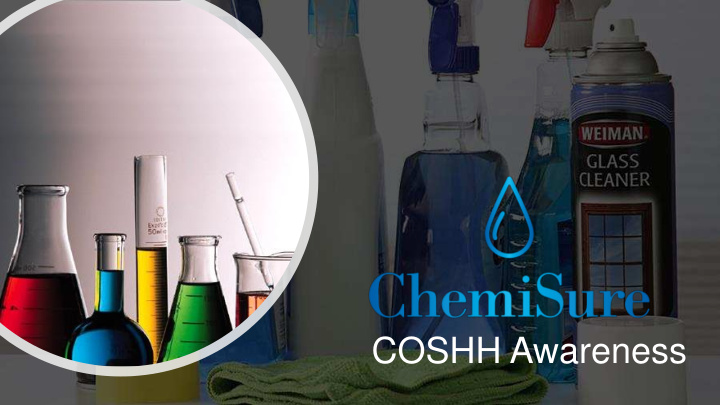



COSHH Awareness
Why you need to know about COSHH Chemicals are an ever present feature of everyday life, some natural, some synthetic. Many are harmless but some are extremely hazardous. Hazardous substances may be a single material or maybe a combination of materials that become hazardous when mixed Some substances may become hazardous as a result of processes in the workplace.
Why you need to know about COSHH Annually, thousands of workers are made ill because of hazardous substances, contracting diseases such as asthma, cancer, skin diseases etc… These diseases cost many millions of pounds to: • People – who may lose their jobs • Society in disability payments, treatment and drugs • Industry – replacing skilled, trained workers
Why you need to know about COSHH Case Study 1 Workers at a company in Bristol were exposed to hazardous chemicals over a 4 year period resulting in them developing a form of dermatitis (skin disease). One of the workers suffered skin cracking, blisters and weeping wounds for 4 years as a result of the dermatitis. The company was fined £100,000 and ordered to pay £30,000 in costs. Case Study 2 A school cook, in her forties, who had been working with flour in a poorly ventilated room, developed severe asthma that resulted in her barely being able to walk and sleep sitting upright. She was forced to retire early due to ill health. The Courts awarded compensation of £200,000
Why you need to know about COSHH Despite the compensation pay- outs, no amount of money will ever be able to recover the workers HEALTH
Hazardous Substances in the Workplace So, which chemicals cause harm to us? Potentially, a ll of them..…if you don’ t know how to use them properly Some examples of occupations at risk: WELDING CATERING DECORATING CLEANING HEALTHCARE CONSTRUCTION CLEANING WORKING WITH OILS WORKING WITH OILS
Hazardous Substances in the Workplace Hazardous substances come in many forms: Radioactive materials, • Chemicals lead & asbestos have their • own sets of specific Fumes regulations. • Dust All remaining hazardous • Vapours materials are dealt with • Mists under the Control of • Gases Hazardous Substance • Regulations – COSHH Biological agents (bacteria)
Hazardous Substances in the Workplace 4 main routes into the body: • Inhalation (breathed in through nose or mouth) • Ingestion (taken through the mouth and swallowed) • Absorption (passed through the skin into the bloodstream • Injection (passed through broken skin or piercing the skin – needle or stick injury)
Hazardous Substances in the Workplace Once the hazard has entered the body it can cause illnesses including: • Cancer • Lung Disease • Respiratory Conditions (such as asthma) • Skin problems (such as dermatitis) • Nervous System Disorders
Identifying Hazardous Substances Labelling In 2015 a new regulation the Classification, Labelling and Packaging of Substances was introduced known as the CLP Regulation. Previously labels were orange and black they have now been replaced with white, black and red pictograms.
Identifying Hazardous Substances Oxidising Explosive Gas Under Corrosive Flammable Pressure Acute Toxicity Serious Health Health Hazard Hazardous to Hazard The Environment
Identifying Hazardous Substances Chemical Safety Data Sheets Chemical safety data sheets are required by the Registration, Evaluation, Authorisation of Chemicals Regulation (REACH). Suppliers of chemicals must provide current, relevant data sheets if a substance is dangerous to supply. Safety data sheets will provide information on chemicals so that an adequate risk assessment can be carried out, including safe handling, the hazards presented by the substance, storage, emergency measures in case of an incident with the product etc…
Legal Requirements under COSHH COSHH regulations place a number of responsibilities on both the employee and employer. The employer must: • Assess the risks posed by hazardous substances suitably and sufficiently • Implement control measures to regulate hazardous substances and ensure they are maintained adequately • Provide employees with information, instruction and training that is suitable and sufficient
Legal Requirements under COSHH The employer must also: • Draw up emergency procedures • Provide health surveillance where necessary • Ensure workplace exposure limits (WELs) are not exceeded • Carry out a COSHH assessment Employees must: • Use any hazardous substances safely and according to instruction given • Read information and signs displayed • Report any deficiencies in the control measures
Legal Requirements under COSHH Employees must also: • Wear and store PPE as instructed to do so • Maintain a high level of personal hygiene • Use facilities provided for washing • Remove any clothing that may cause contamination before eating
Important Considerations • Use only approved chemicals • Never mix chemicals • Never decant chemicals unless the container is properly labelled • Always store chemicals safely separately from food • Only use chemicals for the purpose they are intended • Always wear protective clothing • Keep COSHH information in a safe and accessible place • ALWAYS follow manufactures instructions • If you are ever unsure check the product information
Recommend
More recommend